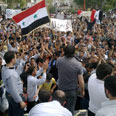
Report: Syrian forces kill 34 protesters
Hama residents say security forces, including snipers, fired from automatic rifles at thousands of demonstrators in some of biggest protests city has seen since uprising against President Assad erupted
Syrian security forces killed at least 34 pro-democracy demonstrators on Friday when they opened fire at protests in the city of Hama, the Syrian human rights organization Sawasiah said.
Three residents said that security forces, including snipers, fired from automatic rifles at thousands of demonstrators in the old quarter and in the nearby Assi Square in some of the biggest protests the city has seen since the uprising against President Bashar Assad erupted in March.
- Receive Ynetnews updates directly to your desktop
Scores of casualties were taken to the Horani hospital in the city, they added.
Hama, 300 km (186 miles) north of Damascus, was attacked in the 1980s by troops to crush an Islamist-led uprising.
The regime also cut Internet service across most of the country, activists said, a potentially dire blow for a movement that motivates people with graphic YouTube videos of the crackdown and loosely organizes protests on Facebook pages.
The Internet shutdown, if it continues, could also hamper the movement's ability to reach the world outside Syria, where the government has severely restricted the media and expelled foreign reporters, making it nearly impossible to independently verify what is happening there. Still many activists found alternate ways to log on and upload vidoes, such as satellite connections.
Rami Abdul-Rahman, director of the Syrian Observatory for Human Rights, said tens of thousands of people were protesting in Hama when security forces opened fire. He said the Hama protest was among the largest yet in the 10-week uprising against President Bashar Assad's regime.
Syria's state-run TV said three "saboteurs" were killed when police tried to stop them from setting a government building on fire in Hama. The Syrian government blames armed gangs and religious extremists for the violence.
As the Friday Muslim prayers ended, worshippers left the mosques and marched in cities, towns and villages. Syrian security forces dispersed some, mostly using batons, tear gas and water cannons and fired live ammunition in at least two locations in southern and northeastern towns.
'No dialogue with the killers of children'
Rights groups say more than 1,100 people have been killed since the revolt against Assad erupted in mid-March.
An eyewitness in Hama reached by The Associated Press said unprecedented numbers of people took part in Friday's protest in Hama.
He described a chaotic scene, with security forces firing tear gas and live ammunition and snipers shooting from the rooftops as people fled. He said there were around 150,000 demonstrators.
"There are many killed and wounded people, the hospital is full," he said. "I fled the area but I can still hear sporadic gunfire."
Syrian troops also pounded the central town of Rastan with artillery and gunfire, killing at least two people. The Local Coordination Committees, which helps organize and document Syria's protests, says troops also opened fire on residents fleeing the town.
Friday's deaths bring the toll in Rastan and nearby Talbiseh to 74 killed since the attack started last Saturday.
The opposition has called for nationwide rallies Friday to commemorate the nearly 30 children killed by Assad's regime during the uprising.
In the southern city of Daraa, where the uprising began 10 weeks ago, scores of people rallied in the city's old quarter, chanting "No dialogue with the killers of children," an activist said.
The protesters were referring to a decree by Assad to set up a committee tasked with leading a national dialogue.
The regime also released hundreds of political prisoners this week after Assad issued a pardon. The Syrian Observatory for Human Rights said leading Kurdish politician Mashaal Tammo and Muhannad al-Hassani, who heads the Syrian Organization for Human Rights, were released Thursday.
Friday's protests reached nearly throughout the country, from a village in the south to a city in the northeast. Protesters even gathered in several Damascus suburbs, though the capital has not seen the kind of disruption as many other cities.
Human rights activist Mustafa Osso said Syrian security forces opened fire Friday at demonstrators in the southern village of Inkhil, but it was not clear if there were any casualties.
A Syrian activist said authorities cut Internet service in several parts of the country, apparently to prevent activists from uploading footage of the protests and the government crackdown and from organizing new resistance. In Damascus, several people contacted over the phone said the Internet was down.
Video surfaced earlier this week on YouTube, Facebook and websites of Hamza al-Khatib, a 13-year-old boy whose tortured and mutilated body was returned to his family weeks after he disappeared during the protests.
The boy has since become a symbol to Syria's uprising and many people carried his posters during anti-regime rallies this week.
"They are worried about today's demonstrations after Hamza al-Khatib's video," said the activists, speaking on condition of anonymity for fear of government reprisals.
The Associated Press and Reuters contributed to this report
- Follow Ynetnews on Facebook










